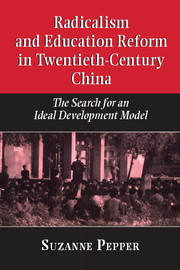Book contents
- Frontmatter
- Contents
- Acknowledgments
- 1 Educational development and the Chinese experience
- Part I The republican era: origins of radical education reform
- Part II Learning from the Soviet Union
- 7 Introducing the Soviet Union
- 8 The Soviet model for Chinese higher education
- 9 Sino-Soviet regularization and school system reform
- 10 Blooming, contending, and criticizing the Soviet model
- Part III Cultural revolution and radical education reform
- Appendix: the Hong Kong interviews
- Select bibliography
- Index
10 - Blooming, contending, and criticizing the Soviet model
Published online by Cambridge University Press: 04 August 2010
- Frontmatter
- Contents
- Acknowledgments
- 1 Educational development and the Chinese experience
- Part I The republican era: origins of radical education reform
- Part II Learning from the Soviet Union
- 7 Introducing the Soviet Union
- 8 The Soviet model for Chinese higher education
- 9 Sino-Soviet regularization and school system reform
- 10 Blooming, contending, and criticizing the Soviet model
- Part III Cultural revolution and radical education reform
- Appendix: the Hong Kong interviews
- Select bibliography
- Index
Summary
With higher education restructured to produce the talent needed for industrialization, the gradual 20th-century separation of Chinese intellectuals from their inherited association with bureaucratic and political power seemed virtually complete. Professionally, however, Chinese educators were far from being disempowered. They had already registered marked success in adjusting their realm to suit old assumptions about how schools should be run, under the guise of adapting the Soviet import to Chinese conditions. At every point where such adjustments occurred, they merged right rather than left, that is, in a line of convergence with China's own regularization mode rather than its critical countercurrent. Just how far professional educators would have liked to go in that direction became evident during 1956 and 1957 – as did the full extent of the forces arrayed against them.
The revelations were part of a much larger exercise initiated by CCP leaders themselves in an effort to regain their balance after leaning so heavily “to one side.” No sooner had they made that decision in 1949 than Josef Stalin died, in 1953, preparing the way for important changes within the Soviet bloc. These changes were heralded by new Soviet leader Nikita Khrushchev's report criticizing Stalin at the Soviet Union's 20th Communist Party Congress in February 1956. The consequences for the CCP were at best politically embarrassing and nowhere more so than in its relationship with the academic community, where initial reluctance to jump on the Soviet bandwagon was well known.
- Type
- Chapter
- Information
- Radicalism and Education Reform in 20th-Century ChinaThe Search for an Ideal Development Model, pp. 217 - 256Publisher: Cambridge University PressPrint publication year: 1996



